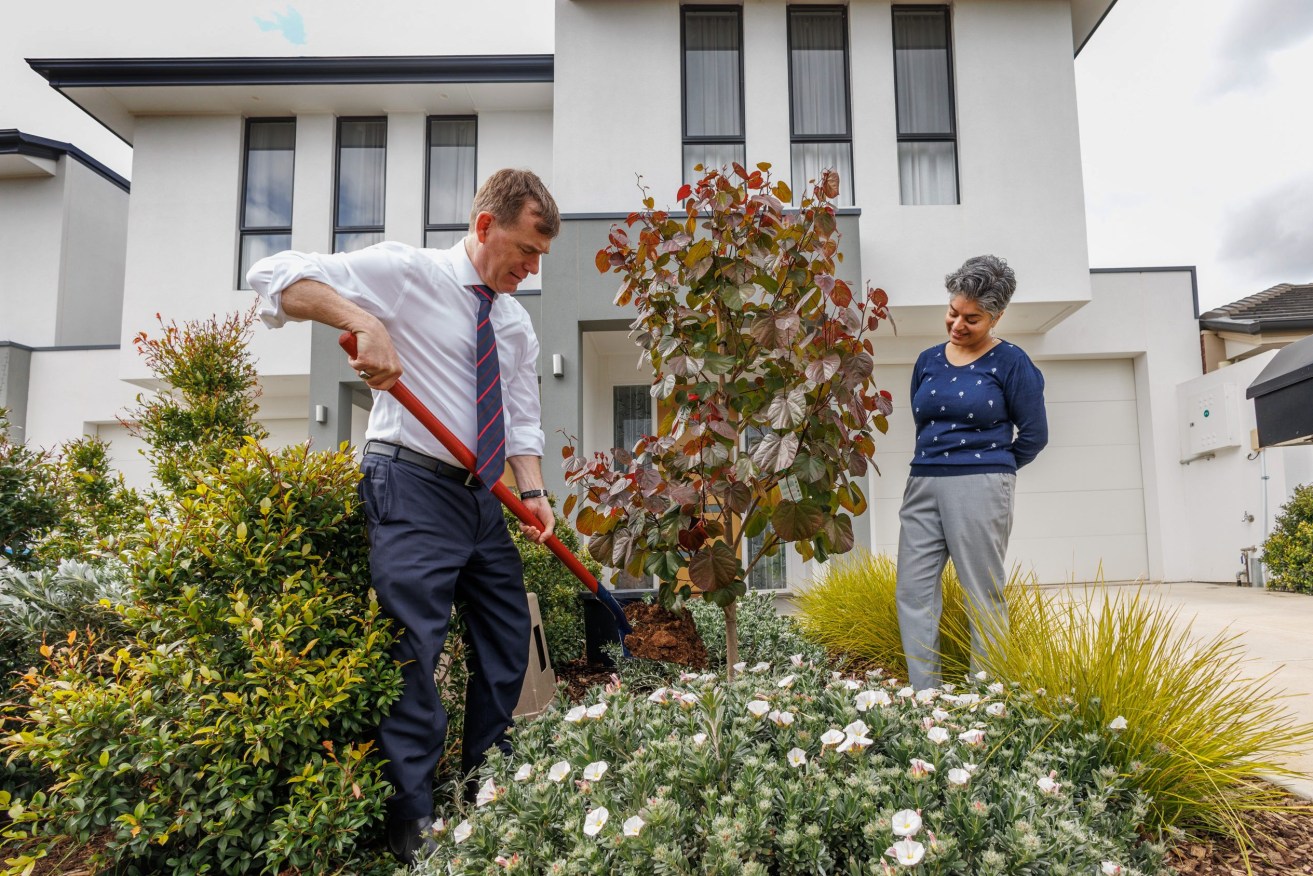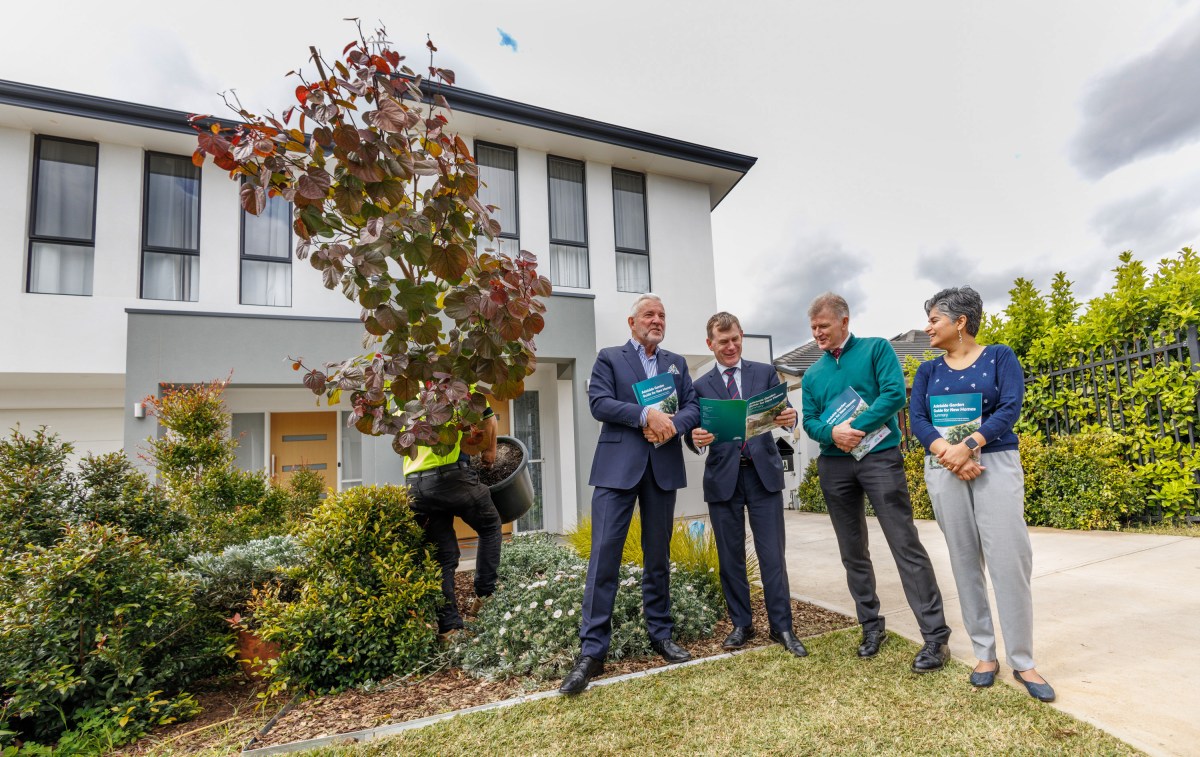‘Environmental challenge’: Govt concern over trees axed for housing
Infill housing in metropolitan Adelaide and the felling of trees for development has prompted concerns about South Australia’s canopy targets, as a university report finds the state’s urban tree protection laws are among the weakest in the nation.

Planning and Urban Development Minister Nick Champion (left) planting a tree at homeowner Megha's house this morning. Photo: Tony Lewis/InDaily
The report by the University of Adelaide, published in May and released publicly today, found the “vast majority” of Australian capital city local governments have more effective urban tree protection laws compared to South Australia.
It found that while metropolitan Adelaide does not have the weakest tree protections in the country, South Australian laws are “markedly less stringent” than those enforced by councils in New South Wales, Victoria and Western Australia.
“The management of trees in Adelaide’s built-up areas has become a topic of increasing attention, particularly given concern that some Adelaide suburbs have very low tree cover and the city as a whole is not on track to meet greening targets under the 30-Year Plan for Greater Adelaide,” the report stated.
“Canopy retention and growth on private land will need to be increased in order to meet the canopy growth targets within the 30-Year Plan and several local government plans.”
The government’s 30-Year Plan sets a target to increase urban green cover by 20 per cent by 2045 for council areas with less than 30 per cent of tree canopy, and no net loss of trees for councils which are already past that threshold.
But an increase in the subdivision of blocks has created more pockets of infill homes.
The government says this form of development now makes up about 40 per cent of new housing in metropolitan Adelaide, with existing vegetation often cleared from redeveloped or subdivided blocks.
“This has contributed to an environmental challenge of not enough greenery and mature trees in the state’s city and suburbs,” it said in a statement.
The government today launched a new guide to help those building new homes or extensions to add more greenery.
The “Adelaide Garden Guide for New Homes” aims to advise developers, applicants, planning professionals and new homeowners on how they can adopt the tree planting and soft landscaping policies within the state’s planning and design code.
It also outlines how new developments can respond better to climate change.

SA Planning Commission chair Craig Holden, Planning Minister Nick Champion, Green Adelaide director Brenton Grear and homeowner Megha with the new guide. Photo: Tony Lewis/InDaily
Planning and Urban Development Minister Nick Champion said the Malinauskas Government had committed to increase the green canopy in Adelaide and create regulations that match the strongest in the country.
“This is a positive step towards achieving that goal,” he said.
“We all need to do more to create a cooler, greener Adelaide, and one of the ways to achieve this is through making the conscious effort to build-in greenery when we build new homes as well as look after existing mature trees.”
It comes after InDaily reported on Monday that the government spent $1.4 million purchasing a property at Black Forest to save two surviving remnant grey box trees from the threat of the developers’ axe.
The University of Adelaide review was commissioned by the state’s Planning Department after the Conservation Council of SA last year released a report claiming that metropolitan Adelaide had “the worst tree protections” in Australia following a study of 47 local government areas.
The university study analysed tree protection laws across 101 local governments in Australian capital cities, as well as state-level regulations across Australia.
It found that South Australia has a “narrow” classification of protected trees compared to other states, with trees only deemed “regulated” or “significant” if they have a trunk circumference of more than two metres when measured at a height of one metre above ground. The report found other states have an average circumference threshold for protection of 50 centimetres.
Over half of the reviewed councils also protect trees exceeding a given height or crown spread, but those protections do not exist in South Australia.
The researchers noted that South Australian trees can be listed on the National Trust’s significant tree register if they have exceptional qualities, but they do not receive additional legal protections, unlike in several other jurisdictions.
They found penalties for unlawfully damaging or removing a protected tree in South Australia are broadly consistent with other states and territories, but multiple interstate councils impose additional penalties under local laws – ranging from $100 to $500,0000.
The report made 23 recommendations to the state government, including reducing the circumference threshold for protected trees in South Australia from two metres to 50 centimetres, implementing independent dimension-based protection thresholds for height and crown spread, and ensuring arborists are involved in the assessment of significant trees.
“It is recognised that these recommendations will create an environment whereby the cost to damage or remove regulated or significant trees is significantly more expensive than is currently the case,” the researchers stated.
“This is deliberate, and will create a culture in which retention of trees remains the default, rather than the current default of removal.”
The report has been handed to the government’s expert planning panel presiding member John Stimson to consider as part of his work reviewing the state’s planning system.
A separate arborist review by Dr Dean Nicolle, which analyses tree species exemptions and a value/cost assessment of particular tree species, has also been handed to Stimson.




